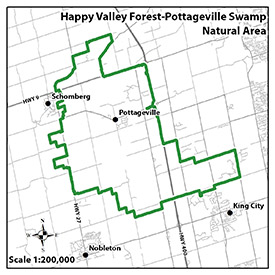Happy Valley Forest – Pottageville Swamp Natural Area
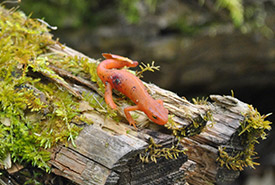
Red eft in Happy Valley Forest (Photo by NCC)
Why this place is important
Surrounded by the growing metropolis of the Greater Toronto Area (GTA) in southern Ontario, Happy Valley Forest – Pottageville Swamp is a natural oasis with vast ecological, historical and cultural importance.
Located in King Township, this 8,737-hectare (21,589-acre) natural area supports at least 30 species listed as at risk by the Committee on the Status of Endangered Wildlife in Canada and 29 provincially listed species at risk. Happy Valley Forest is the largest intact block of deciduous forest on the Oak Ridges Moraine. It is an outstanding example of the mature sugar maple and beech upland forests of the moraine. Nearby Pottageville Swamp is a Provincially Significant Wetland made up primarily of treed wetlands.
What NCC is doing here
With mounting residential and industrial pressures throughout the GTA, it is critical that we also conserve local natural areas so that they can continue to clean our air, filter our water, and provide opportunities for residents to connect with nature. To date, the Nature Conservancy of Canada (NCC) has protected 316 hectares (780 acres) at the core of the Happy Valley Forest. It is our goal to protect even more of this important natural area and manage it for the long term.
A forest for the future
The Happy Valley Forest is an old-growth forest in the making. This means that if we can continue to care for and protect this unique landscape, the forest will achieve old-growth status in the next 50 to 100 years.
The forest is being conserved at a scale large enough to allow for natural disturbances. Wildfires, insect outbreaks, disease and severe storms can significantly impact the structure and composition of any landscape. Because larger landscapes can accommodate the impact of these natural disturbances, it is important to protect the Happy Valley Forest at this scale. Nowhere else on the western moraine or within the GTA is old-growth forest of this extent achievable. Click here to learn more about the importance of old-growth forests.
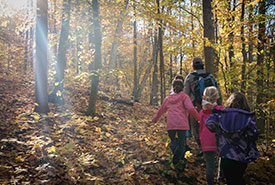
Nature Days, Happy Valley Forest, ON (Photo by HSBC Bank Canada)
With a growing population in the GTA and an increased interest in nature-based recreation, it’s important that we ensure this special place is used responsibly, so that both wildlife and humans can enjoy the forest for generations to come.
By creating and implementing a visitor management plan, NCC is also looking at how Happy Valley Forest can be enjoyed sustainably for generations to come.
NCC’s visitor management plan will include:
- New trail linkages so that trails eliminate trespassing on private land.
- Better signage to ensure good trail etiquette and appropriate trail use.
- Improved wayfinding, including trail maps and blazes
NCC’s first accessible trail in Canada
At NCC, we believe that everyone should have the opportunity to spend time in nature. Whether listening to birds singing in a forest or watching butterflies, frogs and salamanders enjoying a wetland, immersing ourselves in nature can leave people feeling renewed, inspired and connected to our natural world.
The Goldie Feldman Nature Reserve, located in Happy Valley Forest, features NCC’s first fully accessible trail in Canada! The 770-metre trail and parking lot with accessible spaces are built to AODA standards. This trail includes two loops, one through a meadow and one through the forest, to provide different experiences and options for visitors. Learn more about the trail here.
What lives here
These are some of the significant and at-risk species found in this natural area.
Reptiles, amphibians and turtles
- Blanding's turtle (endangered)
- eastern ribbonsnake (special concern)
- Jefferson salamander (endangered)
- milksnake (special concern)
- northern map turtle (special concern)
- snapping turtle (special concern)
- western chorus frog - Great Lakes - St. Lawrence/Canadian Shield population (threatened)
Birds
- bald eagle (special concern)
- bank swallow (threatened)
- barn swallow (threatened)
- bobolink (threatened)
- Canada warbler (threatened)
- cerulean warbler (endangered)
- chimney swift (threatened)
- eastern meadowlark (threatened)
- eastern whip-poor-will (threatened)
- eastern wood-pewee (special concern)
- golden eagle (endangered)
- grasshopper sparrow (special concern)
- least bittern (threatened)
- peregrine falcon (special concern)
- red-headed woodpecker (threatened)
- short-eared owl (special concern)
- wood thrush (threatened)
- yellow-breasted chat (endangered)
Insects
- lilypad clubtail (provincially rare)
- monarch (endangered)
Plants
- butternut (endangered)
- purple twayblade (threatened)
Threats
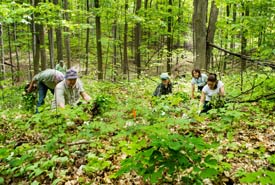
Volunteers pulling garlic mustard at Happy Valley Forest, ON (Photo by Miguel Hortiguela)
Non-native, invasive species are one of the major threats to Happy Valley Forest – Pottageville Swamp. Garlic mustard, dog-strangling vine, phragmites and other invasives crowd out and out-compete native plants, reducing the diversity of the forests and wetlands.
NCC hosts regular Conservation Volunteers events that aim to eradicate these invasives, especially garlic mustard. Brought to North America by early colonists, this invasive alien plant is now spreading across the continent at a rate of 6,400 square kilometres per year — that's an area 10 times the size of Toronto!
The success of garlic mustard is multi-faceted. Aside from having no natural predators in North America, garlic mustard is an early riser, taking advantage of the open canopy of springtime deciduous forests, and of the first rays of sunlight after the winter snow has melted and getting a head start on native plants emerging after it. Garlic mustard can even change a forest's composition over time, creating a more favourable environment for itself, while driving other species out of the understory. This can even extend to the composition of the forest, as garlic mustard can interfere with the germination of tree seeds.
Other threats to this habitat include roads, which can threaten reptiles, amphibians and turtles that try to cross them. Dams and perched culverts, development and unsustainable uses such as ATVs are other threats.
History
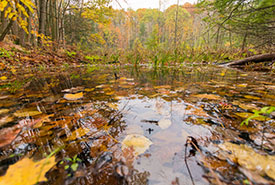
Wetland, Happy Valley Forest, ON (Photo by Graham Kent)
The Happy Valley Forest has a long history of human use. The forest is located along the Toronto Carrying Place, a historic portage and travel route. This prehistoric link between Lake Simcoe and Lake Ontario is roughly 45 kilometres long. Indigenous Peoples and early settlers would carry lightweight birch bark canoes on this long trek — the most direct route between the two lakes.
Much of Happy Valley Forest has been left undisturbed for more than 100 years. This is likely part of the reason it is so biologically rich today.
Since the 1970s, NCC has helped protect more than 323 hectares (800 acres) in Happy Valley Forest – Pottageville Swamp.
Partners
The protection of Happy Valley Forest – Pottageville Swamp is not something we can achieve on our own. Only through strong partnerships can this unique area continue to grow and thrive. NCC would like to thank the following partners for their generous support of our ongoing efforts in this natural area:
- Government of Canada, through the Natural Areas Conservation Program
- Regional Municipality of York
- Lake Simcoe Region Conservation Authority (LSRCA)
- Toronto and Region Conservation Authority (TRCA)
- King Township
- Oak Ridges Moraine Land Trust
- 407 ETR
Current projects
Click here to learn more about our current projects in the Happy Valley Forest – Pottageville Swamp Natural Area.
For more information on this natural area, you can read the Happy Valley - Pottageville Swamp Natural Area Conservation Plan Executive Summary.


